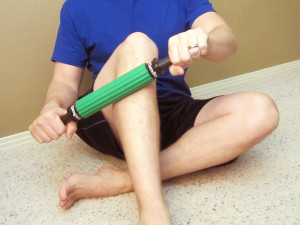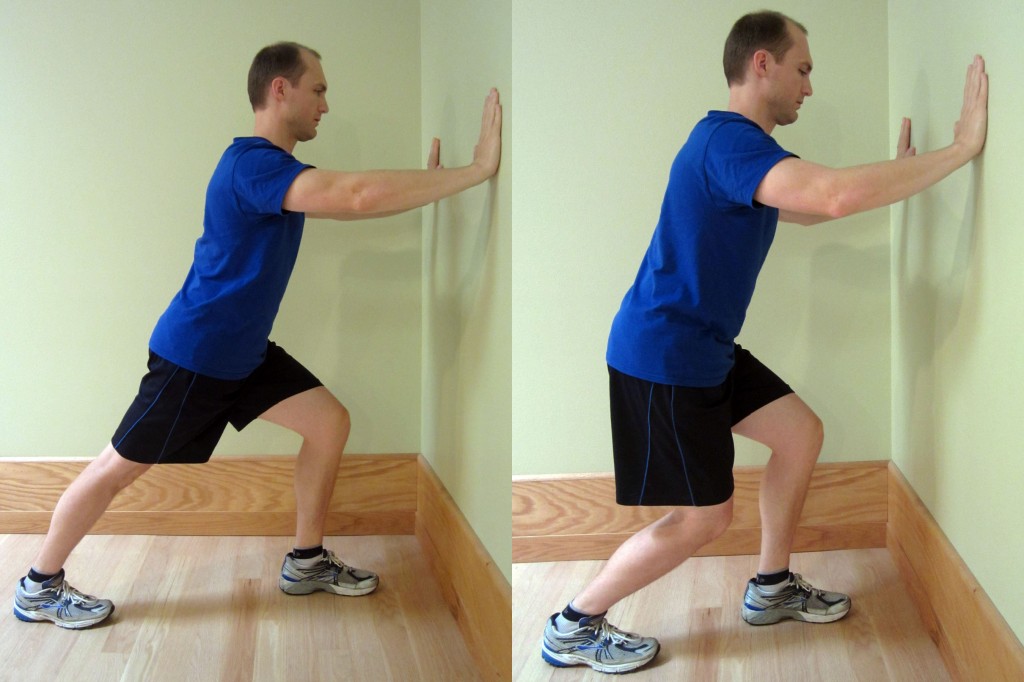If you have ever experienced shin splints (anterior compartment syndrome), you know how excruciatingly painful it can be. You may struggle to run or walk. The pain can linger for weeks and months–taking the fun out of running and exercise. In the previous post, I discussed How to Prevent Shin Splints. Now I will provide simple treatment options to quickly help aid in your recovery. Shin splints can typically be easily self-treated if you don’t have a more serious medical condition, such as a stress fracture, causing the pain.
How to Self-Treat Shin Splints:
- Ice. Although shin splints can occur insidiously, they are often associated with a specific event. An active inflammatory process typically occurs. Apply the ice to the anterior tibialis muscle (the muscle right next to the shinbone). The rule for icing is to apply ice no more than twenty minutes per hour. Do not place the ice directly against the skin, especially if you are using a cold pack. A bag of frozen peas can be a cheap alternative. Individuals with poor circulation or impaired sensation should take particular care when icing.
- Rest. If you are experiencing an episode of shin splints, then you will need to rest. Avoid running (particularly downhill). At the very least, taper your training intensity and avoid exercises that place undue stress on the shins, particularly the anterior tibialis muscle. Utilize this time to incorporate cross training activities, such as yoga, to improve flexibility as shin splints can be linked to poor mobility.
- Consider changing your shoes. Your shoes may be worn out and may be the cause of the pain. If you wear a shoe that helps to limit overpronation, remember that the inner cushion and structure of the shoe can wear out before its outer appearance. If this occurs, the shoe can no longer adequately control inappropriate foot and heel movements such as overpronation. This can lead to shin splints as well as IT band syndrome or other hip, knee, or ankle related issues. Shoes only last 350-500 miles. If you are nearing those miles, then it may be time to change.
- Add an orthotic. Additional foot control is often needed to normalize gait mechanics. Many running stores sell an over-the-counter orthotic such as Superfeet Blue Premium Insoles. The blue tends to fit most feet, but a variety of options are available for customization. In my experience, these insoles can last 1,000 to 1,500 miles easily. If the over-the-counter options aren’t helping you, please see a physical therapist or podiatrist for custom orthotics. Seek assistance from a professional who is a runner and has experience with treating other runners.
- Warm up prior to exercise. I recommend that you increase your normal warm up time by at least 10 minutes in order to increase blood flow to the area. This allows for better mobility and also prepares the tissues for exercise. Consider using a self-massage tool to roll up and down the anterior tibialis as part of your warm up. My favorite self-massage tools for this area include the Thera-Band Standard Roller Massager and The Stick Self Roller Massager. I also recommend using the massager on your calf muscles. Perform calf stretches, but be mindful that prolonged static stretching before exercise may worsen performance.
- Cool down. After performing your exercises, take extra time to cool down and stretch. Focus on calf stretching as well as general lower extremity mobility stretches. Use the same self-massage tools as you did during your warm up. If you are prone to developing shin splints, I highly recommend regular massage and mobilization of the anterior tibialis muscle, as well as the calves. Tightness in the calves and Achilles tendon are a risk factor for developing shin splints. Be sure to emphasize stretching your calves. Hold each of the following stretches for at least 30 seconds, 3 times on each leg, 2-3 times a day. (These stretches shouldn’t cause more than a mild increase in pain or discomfort.)
- Self-mobilize the tissue. Be sure to mobilize the tissue of the anterior tibialis. For this particular area, you may want to use one of the self-massage tools referenced above. You could also use a tennis or lacrosse ball to aggressively work out the tissue along the shin. Remember that mobility issues and myofascial restrictions in the lower legs are highly correlated with the development of shin splints. Use the foam roller to address any lower leg tightness or restrictions. I tend to use the foam roller for the larger parts of the leg including the thigh, back of the leg, calves, and buttock muscles. To learn how to use a foam roller, please refer to Foam Rolling for Rehabilitation.
- Work on the stabilizing muscles of your hips and ankles. As part of a comprehensive rehabilitation protocol, I almost always have clients work on keeping the muscles of the pelvis, hips, and ankles strong. This will help to maintain normal gait mechanics during exercise and running. Not only will this help to prevent shin splints, it will likely help to prevent developing other orthopaedic issues such as plantar fasciitis and hip or knee pain. Please refer to Ankle Resistance Exercises and How to Safely Self-Treat Low Back Pain for my recommended hip and lumbar stabilization strengthening exercises.
- Work on your balance. Poor balance is often associated with muscle weakness in the foot and ankle as well as the knee and hip musculature. Weakness and balance deficits can lead to poor foot mechanics, which can lead to excessive strain. I always include balance work as part of my recommended rehabilitation protocol. Please refer to Improving Balance by Using a Water Noodle, How Do I Improve Balance? (Part I), and How Do I Improve Balance? (Part II).
- Kinesiological taping. The purpose of the tape is to assist the anterior tibialis muscle with its contraction and to possibly help with swelling and nutrient exchange by assisting the lymphatic system. I have had luck using the KT TAPE and Mummy Tape brands. When treating shin splints, I recommend following these step by step instructions for Kinesiological Taping for Shin Splints. For application and removal tips, please refer to Skin Care with Taping.
- Use a compression sleeve or stocking. This condition is often associated with swelling and inflammation in the anterior compartment of the lower leg near the shinbone (tibia). The compression sleeve/socking can help to limit the amount of swelling and promote blood flow back out of the lower leg. This insures better nutrient exchange, waste removal, and can limit the swelling. I particularly recommend wearing a pair while you are in the rehabilitation phase or tapering back into full activity. There are many different styles of compression socks and sleeves, but I prefer Vitalsox Graduated Compression Socks. If you prefer a sock style, then I recommend choosing a pair that is at least knee high.
- Start a supplement. Many herbs help to reduce inflammation and pain. One of my favorites is called Phenocane Natural Pain Management. It combines the following: Curcumin, an herb that reduces pain and inflammation; boswellia, a natural COX2 inhibitor that also reduces pain and inflammation; DLPA, an amino acid that helps to increase and uphold serotonin levels in the brain; and nattokinase, an enzyme that assists with blood clotting and reduces pain and inflammation. (If you are taking blood thinners, please consult with your physician prior to use as the herbs could interact with some medications.)
- Ask for help. If you’re still experiencing pain after implementing these self-treatment strategies, then it may be time to seek additional help. Your medical physician can help to determine if your pain is associated with a stress fracture. He/she could also prescribe stronger anti-inflammatory medication if necessary. The American Physical Therapy Association offers a wonderful resource to help find a physical therapist in your area. In most states, you can seek physical therapy advice without a medical doctor’s referral (although it may be a good idea to seek your physician’s opinion as well).
Have you ever experienced shin splints? If so, which treatment techniques have you found to be the most effective? Please leave your comments below.
Looking for that exercise or book I mentioned in a post? Forgot the name of a product or supplement that you’re interested in? It’s all listed in the new Resource Guide. Check it out today!
If you have a question that you would like featured in an upcoming blog post, please comment below or submit your question to contact@thePhysicalTherapyAdvisor.com. Be sure to join our growing community on Facebook by liking The Physical Therapy Advisor!


